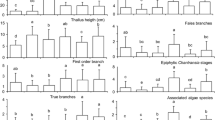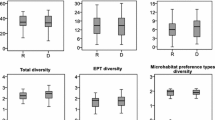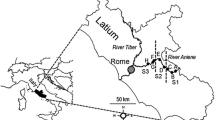Abstract
Aquatic plants mediate ecological processes in aquatic habitats, specifically predator–prey (bluegill sunfish (Lepomis macrochirus Rafinesque)-macroinvertebrate) interactions. Macroinvertebrate colonization is directly and indirectly influenced by substrate heterogeneity, interstitial space, and surface complexity. Exotic invasive plant species, such as Hydrilla verticillata L.F. Royle, may alter the available structure in aquatic habitat by creating a shift to a homogeneous habitat, thus affecting the macroinvertebrate community. Since macroinvertebrates provide a food base for young phytophilic fishes, changes in their density and abundance may alter food webs. We investigated the hypothesis that macroinvertebrate community structure is influenced by differences in habitat heterogeneity by measuring difference between a heterogeneous native aquatic plant bed, homogenous hydrilla plant bed, and habitat with no plants. Studies were conducted in the field (pond) and the experimental treatments were: (1) no plants, (2) monotypic bed of hydrilla, and (3) diverse native plants. Aquatic plants, regardless of species, supported greater macroinvertebrate abundance, richness, and biomass. Macroinvertebrate abundance, richness, and biomass in a hydrilla-dominated habitat did not differ significantly from a diverse plant habitat, except for richness in October. Indicator taxa did differ significantly between respective treatments, suggesting a change in species composition. However, no significant effect of fish predation on macroinvertebrate populations and/or community structure was documented. The data suggest that a shift from a natural mosaic of vegetated habitat to a highly complex monotypic habitat (e.g., exotic hydrilla) may reduce spatial heterogeneity important to structuring a macroinvertebrate assemblage.



Similar content being viewed by others
References
Akaike, H., 1973. Information theory and an extension of the maximum likelihood principle. In Petrov, B. N. & F. Csaki (eds), Second International Symposium on Information Theory. Academiai Kiado, Budapest.
Batzer, D. P., & V. H. Resh, 1991. Trophic interactions among a beetle predator, a chironomid grazer, and periphyton in a seasonal wetland. Oikos 60: 251–257.
Beckett, D. C., T. P. Aartila, & A. C. Miller, 1992. Invertebrate abundance on Potamogeton nodosus: effects of plant surface area and condition. Canadian Journal of Zoology 70: 300–306.
Campeau, S., H. R. Murkin, & R. D. Titman, 1994. Relative importance of algae and emergent plant litter to freshwater marsh invertebrates. Canadian Journal of Zoology 51: 681–692.
Canfield, R. H., 1941. Application of the line intercept method in sampling range vegetation. Journal of Forestry 39: 388–394.
Carpenter, S. R., 1996. Microcosm experiments have limited relevance for community and ecosystem ecology. Ecology 77(3): 677–680.
Carpenter, S. R., & D. M. Lodge, 1986. Effects of submersed macrophytes on ecosystem processes. Aquatic Botany 26: 341–370.
Cheruvelil, K. S., P. A. Soranno, J. D. Madsen, & M. J. Roberson, 2002. Plant architecture and epiphytic macroinvertebrate communities: the role of an exotic dissected macrophyte. Journal of the North American Benthological Society 21(2): 261–277.
Crowder, L. B., & W. E. Cooper, 1982. Habitat structural complexity and the interaction between bluegills and their prey. Ecology 63(6): 1802–1813.
de Szalay, F. A., & V. H. Resh, 1996. Spatial and temporal variability of trophic relationships among aquatic macroinvertebrates in a seasonal marsh. Wetlands 16(4): 458–466.
de Szalay, F. A., & V. H. Resh, 2000. Factors influencing macroinvertebrate colonization of seasonal wetlands: responses to emergent plant cover. Freshwater Biology 45: 295–308.
Dibble, E. D., & S. L. Harrel, 1997. Largemouth bass diets in two aquatic plant communities. Journal of Aquatic Plant Management 35: 74–78.
Dibble, E. D., K. J. Killgore, & G. O. Dick, 1996a. Measurement of plant architecture in seven aquatic plants. Journal of Freshwater Ecology 11(3): 311–318.
Dibble, E. D., K. J. Killgore, & S. L. Harrel, 1996b. Assessment of fish-plant interactions. American Fisheries Society Symposium 16: 357–372.
Dibble, E. D., S. M. Thomaz, & A. A. Padial, 2006. Spatial complexity measured at a multi-scale in three aquatic plant species. Journal of Freshwater Ecology 21(2): 239–247.
Dufrene, M., & P. Legendre, 1997. Species assemblages and indicator species: the need for a flexible asymmetrical approach. Ecological Monographs 67(3): 345–366.
Frodge, J. D., G. L. Thomas, & G. B. Pauley, 1990. Effects of canopy formation by floating and submergent aquatic macrophytes on the water quality of two shallow Pacific Northwest lakes. Aquatic Botany 38: 231–248.
Gerking, S. D., 1957. A method of sampling the littoral macrofauna and its application. Ecology 38: 219–226.
Gilinsky, E., 1984. The role of fish predation and spatial heterogeneity in determining benthic community structure. Ecology 65(2): 455–468.
Haller, W. T., 1978. Hydrilla, a New and Rapidly Spreading Aquatic Weed Problem. Agricultural Experiment Station, Institute of Food and Agricultural Sciences, University of Florida, Gainesville.
Hanson, M. A., & M. R. Riggs, 1995. Potential effects of fish predation on wetland invertebrates: a comparison of wetlands with and without fathead minnows. Wetlands 15(2): 167–175.
Harrel, S. L., & E. D. Dibble, 2001a. Factors affecting foraging patterns of juvenile bluegill (Lepomis macrochirus) in vegetated habitats of a Wisconsin Lake. Journal of Freshwater Ecology 16: 581–589.
Harrel, S. L., & E. D. Dibble, 2001b. Foraging efficiency of juvenile bluegill, Lepomis macrochirus, among different vegetated habitats. Environmental Biology of Fishes 62: 441–453.
Hershey, A. E., & G. A. Lamberti, 2001. Aquatic insect ecology. In Thorp, J. H. & A. P. Covich (eds), Ecology and Classification of North American Freshwater Invertebrates, 2nd edn. Academic Press, San Diego: 733–776.
Hilsenhoff, W. L., 1987. An improved biotic index of organic stream pollution. The Great Lakes Entomologist 20(1): 31–39.
Hilsenhoff, W. L., 2001. Diversity and classification of insects and collembola. In Thorp, J. H. & A. P. Covich (eds), Ecology and Classification of North American Freshwater Invertebrates, 2nd edn. Academic Press, San Diego: 661–731.
Jacono, C. C., & M. M. Richerson, 2007. Hydrilla verticillata. USGS Nonindigenous Aquatic Species Database, Gainesville.
Kornijow, R., R. D. Gulati, & T. Ozimek, 1995. Food preference of freshwater invertebrates: comparing fresh and decomposed angiosperm and a filamentous alga. Freshwater Biology 33: 205–212.
Krecker, F. H., 1939. A comparative study of the animal population of certain submerged aquatic plants. Ecology 20(4): 553–562.
Lillie, R. A., & J. Budd, 1992. Habitat architecture of Myriophyllum spicatum L. as an index to habitat quality for fish and macroinvertebrates. Journal of Freshwater Ecology 7(2): 113–125.
Littell, R. C., P. R. Henry, & C. B. Ammerman, 1998. Statistical analysis of repeated measures data using SAS procedures. Journal of Animal Science 76: 1216–1231.
Littell, R. C., G. A. Milliken, W. W. Stroup, R. D. Wolfinger, & O. Schabenberger, 2006. SAS System for Mixed Models. SAS Institute, Cary.
Madsen, J. D., 1997. Methods for management of nonindigenous aquatic plants. In Luken, J. O. & J. W. Thieret (eds), Assessment and Management of Plant Invasions, Springer-Verlag, New York: 145–171.
Madsen, J. D., 1999. Point intercept and line intercept methods for aquatic plant management. Technical note APCRP-MI-02-U.S. Army Engineer Research and Development Center, Vicksburg, MS.
McCune, B., & J. B. Grace, 2002. Analysis of Ecological Communities. MjM Software Design, Gleneden Beach, Oregon.
McCune, B., & M. J. Mefford, 1999. PC-ORD. Multivariate Analysis of Ecological Data. MjM Software, Gleneden Beach, Oregon.
Meals, K. O., & L. E. Miranda, 1991. Variability in abundance of age-0 centrarchids among littoral habitats of flood control reservoirs in Mississippi. North American Journal of Fisheries Management 11: 298–304.
Merritt, R. W., & K. W. Cummins, 1996. An Introduction to the Aquatic Insects, 3rd edn. Kendall & Hunt Publishing Company, Dubuque, Iowa.
Mielke, P. W., & H. K. Iyer, 1982. Permutation techniques for analyzing multi-response data from randomize block experiments. Communications in Statistics—Theory and Methods A11: 1427–1437.
Murkin, H. R., D. A. Wrubleske, & F. A. Reid, 1996. Sampling invertebrates in aquatic, terrestrial habitats. In Bookhout, T. A. (ed.), Research and Management Techniques for Wildlife and Habitats, 5th edn. The Wildlife Society, Inc., Bethesda: 349–369.
Nelson, J. W., J. A. Kadlec, & H. R. Murkin, 1990. Responses by macroinvertebrates to cattail litter quality and timing of litter submergence in a northern prairie marsh. Wetlands 10(1): 47–60.
Pennak, R. W., 1989. Fresh-water Invertebrates of the United States, 3rd edn. John Wiley and Sons, Incorporated, New York.
Posey, M. H., C. Wigand, & J. C. Stevenson, 1993. Effects of an introduced aquatic plant, Hydrilla verticillata, on benthic communities in the Upper Chesapeake Bay. Estuarine, Coastal and Shelf Science 37: 539–555.
Rose, C., & W. G. Crumpton, 1996. Effects of emergent macrophytes on dissolved oxygen dynamics in a prairie pothole wetland. Wetlands 16(4): 495–502.
Santamaria, L., 2002. Why are most aquatic plant widely distributed? Dispersal, clonal growth and small-scale heterogeneity in a stressful environment. Acta Oecologica 23: 137–154.
SAS, 2003. SAS 9.1 Qualification Tools User’s Guide. SAS Institute, Inc., Cary.
Schmude, K. L., M. J. Jennings, K. J. Otis, & R. R. Piette, 1998. Effects of habitat complexity on macroinvertebrate colonization of artificial substrates in north temperate lakes. Journal of the North American Benthological Society 17(1): 73–80.
Schramm H. L. Jr., & K. J. Jirka, 1989a. Effects of aquatic macrophytes on benthic macroinvertebrates in two Florida lakes. Journal of Freshwater Ecology 5(1): 1–12.
Schramm H. L. Jr., & K. J. Jirka, 1989b. Epiphytic macroinvertebrates as a food resource for bluegills in Florida lakes. Transactions of the American Fisheries Society 118: 416–426.
Schramm H. L. Jr., K. J. Jirka, & M. V. Hoyer, 1987. Epiphytic macroinvertebrates on dominant macrophytes in two central Florida lakes. Journal of Freshwater Ecology 4(2): 151–161.
Smart, R. M., & J. W. Barko, 1988. Effects of water chemistry on aquatic plants: interrelationships among biomass production, plant nutrition, and water chemistry. U.S. Army Engineer Waterways Experiment Station, Final report A-88-5, Vicksburg, Mississippi.
Smart, T. S., J. Riley, & P. Edwards, 1998. Statistical aspects of aquaculture research: sample sizes for pond experiments. Aquaculture Research 29: 373–379.
Theel, H. J., 2007. Habitat alteration by hydrilla and its effect on macroinvertebrate community structure and bluegill foraging efficiency. M.S. Thesis, Mississippi State University.
Thorp, A. G., R. C. Jones, & D. P. Kelso, 1997. A comparison of water-column macroinvertebrate communities in beds of differing submersed aquatic vegetation in the tidal freshwater Potomac River. Estuaries 20(1): 86–95.
Thorp, J. H., & E. A. Bergey, 1981. Field experiments on responses of a freshwater, benthic macroinvertebrate community to vertebrate predators. Ecology 62: 365–375.
Waters, N. M., & C. R. San Giovanni, 2002. Distribution and diversity of benthic macroinvertebrates associated with aquatic macrophytes. Journal of Freshwater Ecology 17(2): 223–232.
Watkins II C. E., J. V. Shireman, & W. T. Haller, 1983. The influence of aquatic vegetation upon zooplankton and benthic macroinvertebrates in Orange Lake, Florida. Journal of Aquatic Plant Management 21: 78–83.
Zimmer, K. D., M. A. Hanson, & M. G. Butler, 2000. Factors influencing invertebrate communities in prairie wetlands: a multivariate approach. Canadian Journal of Zoology 57: 76–85.
Acknowledgments
We thank L. D’Abramo and B. Leopold for their valuable editorial comments. Much appreciation goes to B. LaValley and A. Wiseman for their support in the laboratory at processing macroinvertebrate samples, and to A. Perret and R. Theel for assisting in the field. This research was supported by the U.S. Geological Survey Biological Resources Discipline Invasive Species Program, under award number 04HQAG013504101049. We thank MAFES personnel at Mississippi State University's Aquaculture facility.
Author information
Authors and Affiliations
Corresponding author
Additional information
Handling editor: S. M. Thomaz
Rights and permissions
About this article
Cite this article
Theel, H.J., Dibble, E.D. & Madsen, J.D. Differential influence of a monotypic and diverse native aquatic plant bed on a macroinvertebrate assemblage; an experimental implication of exotic plant induced habitat. Hydrobiologia 600, 77–87 (2008). https://doi.org/10.1007/s10750-007-9177-z
Received:
Revised:
Accepted:
Published:
Issue Date:
DOI: https://doi.org/10.1007/s10750-007-9177-z




